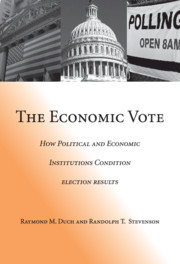Book contents
- Frontmatter
- Contents
- Preface
- 1 Introduction
- Part I Describing the Economic Vote in Western Democracies
- Part II A Contextual Theory of Rational Retrospective Economic Voting: Competency Signals
- Part III A Contextual Theory of Rational Retrospective Economic Voting: Strategic Voting
- Part IV Conclusion and Summary
- Appendix A
- Appendix B
- Appendix C
- References
- Index
- Cambridge Cultural Social Studies
Part III - A Contextual Theory of Rational Retrospective Economic Voting: Strategic Voting
Published online by Cambridge University Press: 06 July 2010
- Frontmatter
- Contents
- Preface
- 1 Introduction
- Part I Describing the Economic Vote in Western Democracies
- Part II A Contextual Theory of Rational Retrospective Economic Voting: Competency Signals
- Part III A Contextual Theory of Rational Retrospective Economic Voting: Strategic Voting
- Part IV Conclusion and Summary
- Appendix A
- Appendix B
- Appendix C
- References
- Index
- Cambridge Cultural Social Studies
Summary
The previous section explored the conditions under which rational voters can extract signals about incumbent competence from movements in the economy. The theory pointed to specific economic contexts that should condition the strength of the competency signal and, consequentially, the importance of the economy in the vote choice. Furthermore, our empirical analysis was largely consistent with those implications. We now propose to explore two aspects of economic voting that were not developed in the model in Chapter 5.
First, in Chapter 8, we generalize the model in Chapter 5 – where only one party was responsible for economic decision making – to multiparty contexts in which policy-making authority may be shared among many – or even all – parties (including opposition parties). We show that in political contexts in which policy-making authority is widely shared, the rational voter's ability to extract an informative signal about the competence of any one party declines. Chapter 9 explores empirically how variations in the distribution of policy-making responsibility among parties currently in government affect the economic vote.
The model developed in Chapter 3 assumed two parties competing for total control of executive authority. Chapter 8 generalizes this model of rational economic voting to contexts in which there are multi-parties (rather than simply two) competing for election and where executive authority is shared (rather than controlled by a single party). This multiparty competition and shared executive authority necessarily introduces incentives for strategic voting.
- Type
- Chapter
- Information
- The Economic VoteHow Political and Economic Institutions Condition Election Results, pp. 207 - 208Publisher: Cambridge University PressPrint publication year: 2008

